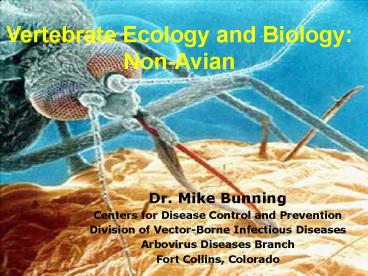Vertebrate Ecology NonAvian - PowerPoint PPT Presentation
1 / 29
Title: Vertebrate Ecology NonAvian
1
Vertebrate Ecology and Biology Non-Avian
Dr. Mike Bunning Centers for Disease Control and
Prevention Division of Vector-Borne Infectious
Diseases Arbovirus Diseases Branch Fort Collins,
Colorado
2
Objectives
- Review vertebrate (non-avian) species
- Review of National Surveillance Data
- Research Projects
- Equine
- Canine
- Feline
- Swine
- New Information
- Serosurvey Results from 2002
3
Epizootic West Nile Virus in the United States,
1999-2002
- Alpaca
- Horses
- Big Brown Bat
- Little Brown Bat
- Cat
- Dog
- Grey Squirrel
- Llama
- Alligator
- Wolf
- Fox Squirrel
- Sheep
- Eastern Chipmunk
- Rocky Mountain Goat
- Striped Skunk
- Reindeer
- Domestic Rabbit
- Harbor Seal
Data reported from USDA, CDC (ArboNET) and State
Health and Veterinary Labs
4
Equine Background
- West Nile virus responsible for outbreaks of
encephalomyelitis in humans and equids - Concerns about equine
- Sentinel host for humans
- Dead end or amplification host
- Public Health ramifications
- Incidence in 2002 12,000 cases in US
- Clinical attack rate 0.1 (10)
- Roughly 1 in 3 affected animals die or are
euthanized
5
Equine WNV Initial Trials
- 12 horses range of ages and breeds seronegative
for WNV and SLE - Infect via bites of infected Aedes albopictus
(horse vs crow isolates) - Clinical observations and serum for virus assay
BID for 14 days
- Published Bunning ML, Bowen RA, Cropp CB,
Sullivan KG, Davis BS, Komar N, Godsey MS, Baker
D, Hettler DL, Holmes DA, - Biggerstaff BJ, Mitchell CJ. Experimental
Infection of horses with West Nile virus . Emerg
Infect Dis 20028380-6.
6
(No Transcript)
7
Equine Serology/Viremia Time Line
Clinical case
IgM
IgG
8
Equine Clinical Case
- CNS Disease
- Ataxia
- Circling
- Hind limb weakness
- Proprioceptive deficits
- Lip droop/paralysis
9
Horse 11, Tissue Virus (Log10 PFU/gram)
- Medulla 6.8
- Cerebellum 5.0
- Frontal cortex 5.2
- Occip cortex 4.3
- Hippocampus 3.3
- Cervical cord 5.0
- Thoracic cord 4.0
- Lumbar cord 4.3
- Radial n. neg
- Spleen neg
- Liver neg
10
Equine Conclusions
- Viremias
- Highest viremia
- Day-3 post infection
- 3 Log-10 Vero cell PFU/ml serum
- One clinical case
- Apparent to inapparent 111
- Virus titers in brain and spinal cord, day-9
- Log 104.0 to 10 6.8 PFU/gram
- None of the virgin mosquitoes became infected
11
Equine Conclusions
- Equines infected with WNV develop viremias of low
magnitude and short duration - Infected horses are unlikely to serve as
amplifying hosts for WNV in nature - Care should be taken on postmortem exam
- Clinical attack rate is roughly 10 in
experimental and field studies - Clinical signs usually characteristic of
encephalomyelitis
12
Canine Research
13
Experimental Infection of Canine with WNV
- Is WNV readily transmitted to dogs by feeding of
infected mosquitoes? - What is the duration and magnitude of viremia and
antibody response - Are dogs likely to serve as amplifying hosts?
14
Canine Research Results
- There was no evidence of clinical disease
- Mild leukopenia
- Virus capable of replicating (4/4)
- Virus was not isolated from saliva
- Dogs are not likely to be amplifying hosts
15
Feline Research
16
Cats as West Nile virus hosts
17
Clinical Disease in Feline
- Mild clinical disease, lasting two to three days
18
Oral Transmission
- 2 cats fed a West Nile virus infected mouse, one
daily for 3 days - 2 cats fed a single West Nile virus infected
mouse - Clinical exams, BID serum for virus isolation
19
Feline Oral Transmission Studies
20
Feline Oral Infections
- Cats were readily infected by consuming infected
mice (4/4) - No clinical disease
- Occasional mosquitoes may become infected by
feeding on infected cats
21
Feline Research Results
- Virus capable of replicating (12/12)
- Virus not isolated from saliva
- Mild, nonspecific disease
- Inconsistent hematologic disturbances, fever
- Cats develop a level of viremia that may be
capable of infecting mosquitoes
22
Swine Research
23
Alligators
- Epizootic characterized by neurologic disease
which occurred at a 9,000-head alligator farm in
Florida. - Approximately 300 alligators (Alligator
mississippiensis) died during this outbreak
Picture courtesy of Elliott R Jacobson
Information provided by University of Florida,
preliminary data
24
Alligators
- Of the tissues sampled, liver had the highest
viral loads (maximum 108.9log10 pfu/0.5cm3) - Brain and spinal cord had the lowest viral loads
(maximum 106.6log10 pfu/0.5cm3) each - Viral loads in plasma ranged from 103.6 to 106.5
log10 pfu/mL
25
Slidell, Louisiana West Nile Virus Mammal
Serosurvey -2002
26
(No Transcript)
27
Serosurvey
- First hot spot of summer 2002, ending with
- 37 human cases in St. Tammany Parish, La
- 18 human cases in Slidell, La
- August - October serosurvey teams were assembled
to work in Slidell, LA for collection of
specimens from a wide array of species
28
WNV Mammal Serosurvey Team Members
Kaci Klenk
Stan Langevin
James Kile
John Montenieri
Sarah Lasater
Gabrielle Dietrich
Nick Panella
29
Acknowledgements
- Colorado State University
- Laura Austgen
- Paul Gordy
- Max Teehee
- Dale Baker
- Dick Bowen
- United States Department of Agriculture
- Louisiana State Department of Health
- Raoult Ratard
- Anne Buff
- Erin Brewer
- Slidell Memorial Hosp
- Department of Fish and Wildlife
- Department of Agriculture
- CDC
- Carl Mitchell Nick Komar
- Brent Davis Aaron Kipp
- Derek Thomas Jenn Leheman
- Jeff Chang Steve Stephens
- Sherif Zaki John Montenieri
- Nick Panella Stan Langevin
- Kaci Klenk Sarah Lasater
- James Kile Manuel Amador
- Leah Colton Gary Clark
- Duane Gubler John Roehrig
- Lyle Petersen Grant Campbell
- Andrea Vicari Dan Oleary
- Sue Montgomery Cathy Chow
- Administrative Staff





























